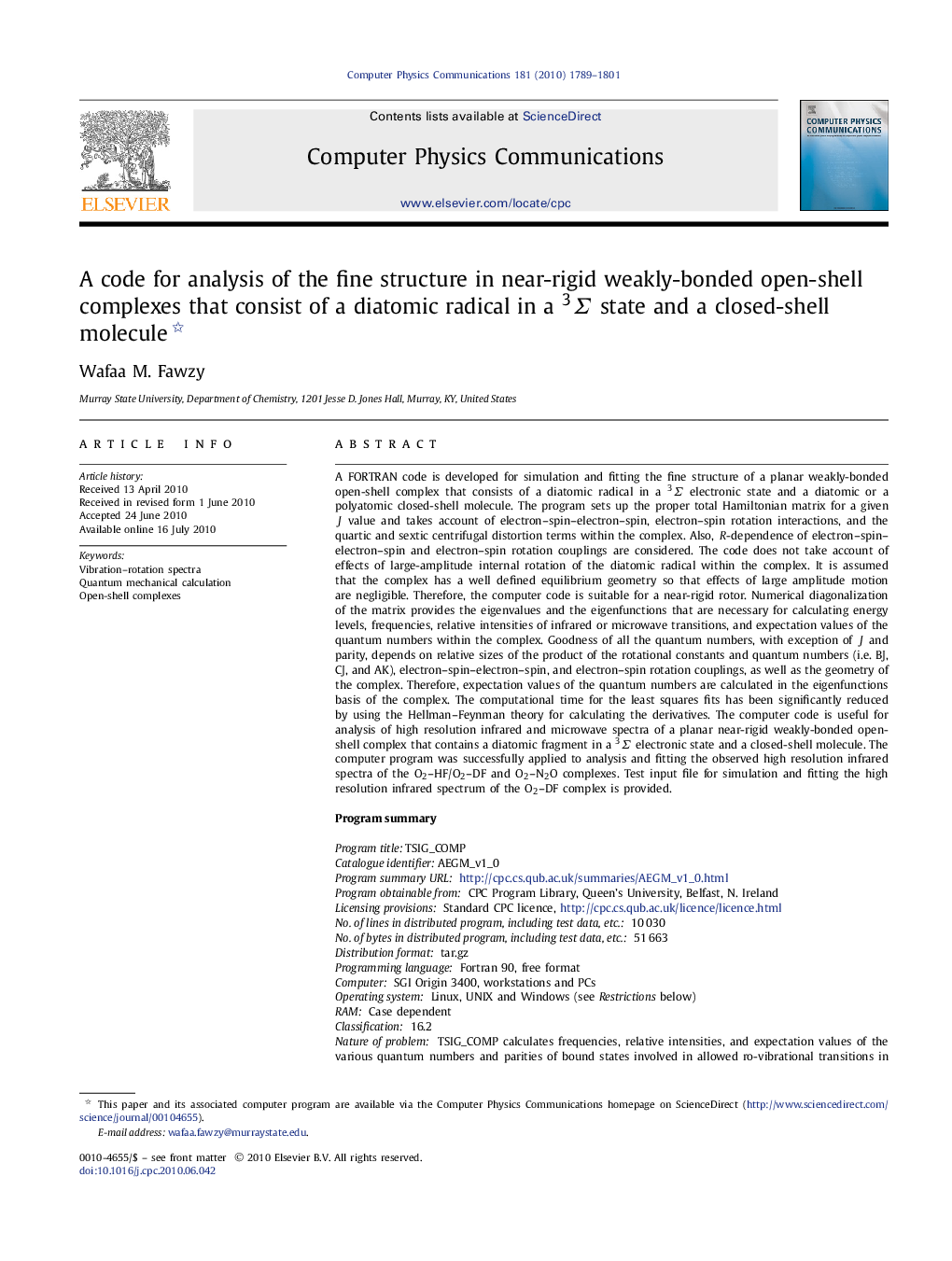| کد مقاله | کد نشریه | سال انتشار | مقاله انگلیسی | نسخه تمام متن |
|---|---|---|---|---|
| 501938 | 863670 | 2010 | 13 صفحه PDF | دانلود رایگان |

A FORTRAN code is developed for simulation and fitting the fine structure of a planar weakly-bonded open-shell complex that consists of a diatomic radical in a Σ3 electronic state and a diatomic or a polyatomic closed-shell molecule. The program sets up the proper total Hamiltonian matrix for a given J value and takes account of electron–spin–electron–spin, electron–spin rotation interactions, and the quartic and sextic centrifugal distortion terms within the complex. Also, R-dependence of electron–spin–electron–spin and electron–spin rotation couplings are considered. The code does not take account of effects of large-amplitude internal rotation of the diatomic radical within the complex. It is assumed that the complex has a well defined equilibrium geometry so that effects of large amplitude motion are negligible. Therefore, the computer code is suitable for a near-rigid rotor. Numerical diagonalization of the matrix provides the eigenvalues and the eigenfunctions that are necessary for calculating energy levels, frequencies, relative intensities of infrared or microwave transitions, and expectation values of the quantum numbers within the complex. Goodness of all the quantum numbers, with exception of J and parity, depends on relative sizes of the product of the rotational constants and quantum numbers (i.e. BJ, CJ, and AK), electron–spin–electron–spin, and electron–spin rotation couplings, as well as the geometry of the complex. Therefore, expectation values of the quantum numbers are calculated in the eigenfunctions basis of the complex. The computational time for the least squares fits has been significantly reduced by using the Hellman–Feynman theory for calculating the derivatives. The computer code is useful for analysis of high resolution infrared and microwave spectra of a planar near-rigid weakly-bonded open-shell complex that contains a diatomic fragment in a Σ3 electronic state and a closed-shell molecule. The computer program was successfully applied to analysis and fitting the observed high resolution infrared spectra of the O2HF/O2DF and O2N2O complexes. Test input file for simulation and fitting the high resolution infrared spectrum of the O2DF complex is provided.Program summaryProgram title: TSIG_COMPCatalogue identifier: AEGM_v1_0Program summary URL:http://cpc.cs.qub.ac.uk/summaries/AEGM_v1_0.htmlProgram obtainable from: CPC Program Library, Queen's University, Belfast, N. IrelandLicensing provisions: Standard CPC licence, http://cpc.cs.qub.ac.uk/licence/licence.htmlNo. of lines in distributed program, including test data, etc.: 10 030No. of bytes in distributed program, including test data, etc.: 51 663Distribution format: tar.gzProgramming language: Fortran 90, free formatComputer: SGI Origin 3400, workstations and PCsOperating system: Linux, UNIX and Windows (see Restrictions below)RAM: Case dependentClassification: 16.2Nature of problem: TSIG_COMP calculates frequencies, relative intensities, and expectation values of the various quantum numbers and parities of bound states involved in allowed ro-vibrational transitions in semi-rigid planar weakly-bonded open-shell complexes. The complexes of interest contain a free radical in a Σ3 state and a closed-shell partner, where the electron–spin–electron–spin interaction, electron–spin rotation interaction, and centrifugal forces significantly modify the spectral patterns. To date, ab initio methods are incapable of taking these effects into account to provide accurate predictions for the ro-vibrational energy levels of the complexes of interest. In the TSIG_COMP program, the problem is solved by using the proper effective Hamiltonian and molecular basis set.Solution method: The program uses a Hamiltonian operator that takes into account vibration, end-over-end rotation, electron–spin–electron–spin and electron–spin rotation interactions as well as the various centrifugal distortion terms. The Hamiltonian operator and the molecular basis set are used to set up the Hamiltonian matrix in the inertial axis system of the complex of interest. Diagonalization of the Hamiltonian matrix provides the eigenvalues and the eigenfunctions for the bound ro-vibrational states. These eigenvalues and eigenfunctions are used to calculate frequencies and relative intensities of the allowed infrared or microwave transitions as well as expectation values of all the quantum numbers and parities of states involved in the transitions. The program employs the method of least squares fits to fit the observed frequencies to the calculated frequencies to provide the molecular parameters that determine the geometry of the complex of interest.Restrictions: The number of transitions and parameters included in the fits is limited to 80 parameters and 200 transitions. However, these numbers can be increased by adjusting dimensions of the arrays (not recommended). Running the program under MS windows is recommended for simulations of any number of transitions and for fitting a relatively small number of parameters and transitions (maximum 15 parameters and 82 transitions), for fitting larger number of parameters run time error may occur. Because spectra of weakly bonded complexes are recorded at low temperatures, in most of cases fittings can be performed under MS windows.Running time: Problem-dependent. The provided test input for Linux fits 82 transitions and 21 parameters, the actual run time is 62 minutes. The provided test input file for MS windows fits 82 transitions and 15 parameters; the actual runtime is 5 minutes.
Journal: Computer Physics Communications - Volume 181, Issue 10, October 2010, Pages 1789–1801